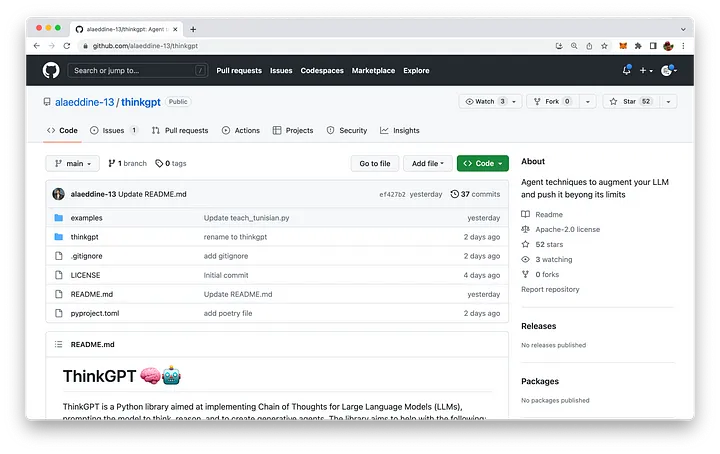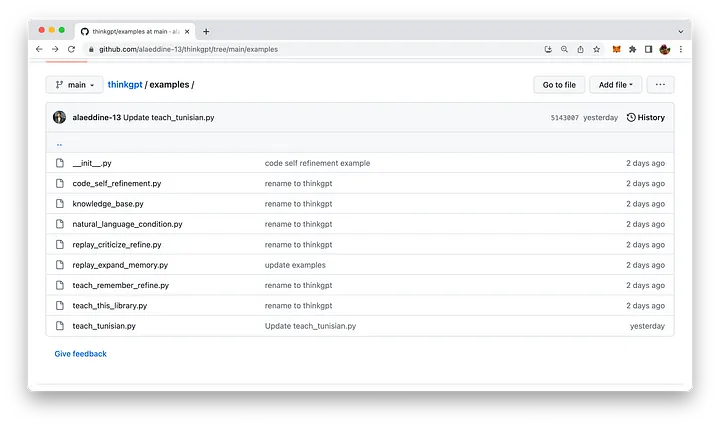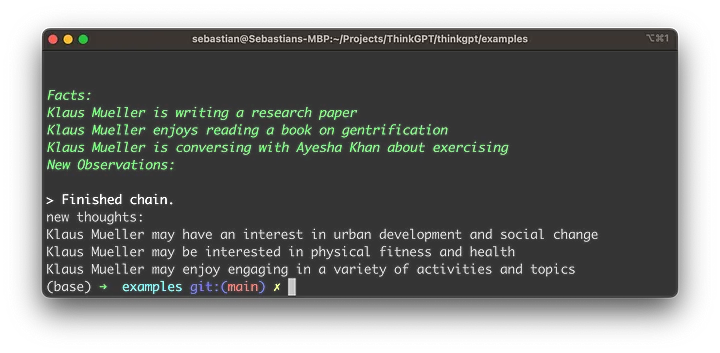 Technology peripherals
Technology peripherals
 AI
AI
 Explore ThinkGPT: the cutting-edge Python library that turns AI into powerful thinking machines
Explore ThinkGPT: the cutting-edge Python library that turns AI into powerful thinking machines
Explore ThinkGPT: the cutting-edge Python library that turns AI into powerful thinking machines
ThinkGPT is an innovative Python library that empowers large language models so that they can think, reason and act more efficiently. If you are eager to integrate ThinkGPT into your Python scripts and take advantage of its advanced features, then please read this article. This article will guide you through the first steps of using ThinkGPT in your Python project.
We will explore ThinkGPT’s core features, including its advanced memory capabilities, self-improvement mechanisms, and high-order reasoning capabilities. You'll be able to discover how this innovative library is changing the AI development landscape, and learn how to harness its power to enhance your own projects.
ThinkGPT is hosted on GitHub. The code base can be found at: https://github.com/alaeddine-13/thinkgpt.

Key Features of ThinkGPT
- Memory: ThinkGPT enables Large Language Models (LLMs) to remember experiences and learn new concepts.
- Self-Improvement: This feature allows the model to improve the generated content by addressing criticisms, fixing issues, and refining its understanding.
- Abstraction: LLM is encouraged to generalize rules from examples or observations, helping to create compressed knowledge that better fits the limited context length of the model.
- Inference: Enables LLM to make educated guesses based on available information.
- Natural Language Conditions: Users can easily express tasks and conditions in natural language, enabling models to make intelligent decisions.
- Easy setup and Pythonic API: Thanks to DocArray, ThinkGPT offers an extremely easy setup process and a Pythonic API.
Installation
Installing ThinkGPT is simple and can be installed using pip:
pip install git+https://github.com/alaeddine-13/thinkgpt.git
This command will install the ThinkGPT library directly from the GitHub code repository.
The first step in using ThinkGPT in Python scripts
After the installation is complete, you can start using ThinkGPT in Python scripts. To do this, simply import the ThinkGPT class from the thinkgpt.llm module and create a new instance of the class:
from thinkgpt.llm import ThinkGPT llm = ThinkGPT(model_name="gpt-3.5-turbo")
This code snippet uses the specified model (in this case " gpt-3.5-turbo") initializes a new ThinkGPT instance.
With a ThinkGPT instance, you can now use the memorize() method to teach your AI model new concepts or facts:
llm.memorize(['DocArray is a library for representing, sending, and storing multi-modal data.'])
To recall memorized information, you can use remember() Method:
memory = llm.remember('DocArray definition')Once the AI model has learned some information, you can use the predict() method to make predictions or answer questions based on the memory data:
llm.predict('what is DocArray ?', remember=memory)This code snippet uses the remember() method to retrieve memory information and feed it back to the predict() method to answer the question.
Practical Examples
ThinkGPT comes with some easy-to-understand usage examples. The corresponding Python script can be found in the example folder of the code repository:

Let's take a closer look at one of the examples provided: replay_expand_memory.py:
from thinkgpt.llm import ThinkGPT llm = ThinkGPT(model_name="gpt-3.5-turbo") # 加载旧内存 old_memory = [ "Klaus Mueller is writing a research paper", "Klaus Mueller enjoys reading a book on gentrification", "Klaus Mueller is conversing with Ayesha Khan about exercising" ] # 教给LLM旧的记忆 llm.memorize(old_memory) # 在旧记忆的基础上诱发反思 new_observations = llm.infer(facts=llm.remember()) print('new thoughts:') print('\n'.join(new_observations)) llm.memorize(new_observations)In this ThinkGPT example script, the goal is to induce new thoughts or observations based on existing information by Klaus Mueller using the ThinkGPT library.
- First, the script imports the ThinkGPT class from the thinkgpt.llm module.
- Create a new ThinkGPT instance and initialize it with the "gpt-3.5-turbo" model.
- Define the old_memory variable, which contains three statements about Klaus Mueller, representing previous knowledge.
- Use the memorize() method to teach a large language model (LLM) the information stored in old_memory.
- Call the infer() method and set the facts parameter to the result of the remember() method. This instructs LLM to induce new observations or thoughts based on previously memorized information.
- Newly induced observations are output to the console under the "new thoughts:" tag.
- Finally, the memorize() method is called again to store the new observations in LLM's memory, allowing it to build an understanding of Klaus Mueller in future interactions.
Before executing the script and viewing the results, we need to obtain the OpenAI API key and set the key value of the corresponding environment variable OPENAI_API_KEY.
To obtain an OpenAI API key, follow these simple steps:
- 请访问OpenAI网站https://www.openai.com/。
- 如果没有帐户,请注册一个帐户。在首页右上角点击“注册”,并按照注册流程操作。
- 注册或登录后,通过点击页面顶部的“API”或访问https://www.openai.com/api/来导航到API部分。
- 查看可用的API定价计划,并选择适合你需求的计划。某些计划可能提供带有有限使用的免费访问权限,而其他计划根据你的要求和预算提供不同级别的访问权限。
- 选择一个计划后,将提供你的唯一API密钥。请确保保密,因为它授予你的账户使用限制和特权的API访问权限。 在命令行中使用以下命令来设置OpenAI API密钥:
export OPENAI_API_KEY="YOUR OPENAI API KEY"
现在我们已经准备好执行脚本了,只需输入以下命令:
python replay_expand_memory.py
然后,你应该能够看到类似于以下的结果:

总结
ThinkGPT是一款强大的Python库,它通过添加先进的记忆、自我完善、抽象和推理功能,增强了大型语言模型的能力。它对用户友好的安装过程和Pythonic API使它成为许多AI项目的有价值的补充。通过探索本文提供的实际示例,你可以利用ThinkGPT的能力,彻底改变你的AI思考方式、得出结论和采取行动的方式。
The above is the detailed content of Explore ThinkGPT: the cutting-edge Python library that turns AI into powerful thinking machines. For more information, please follow other related articles on the PHP Chinese website!

Hot AI Tools

Undresser.AI Undress
AI-powered app for creating realistic nude photos

AI Clothes Remover
Online AI tool for removing clothes from photos.

Undress AI Tool
Undress images for free

Clothoff.io
AI clothes remover

Video Face Swap
Swap faces in any video effortlessly with our completely free AI face swap tool!

Hot Article

Hot Tools

Notepad++7.3.1
Easy-to-use and free code editor

SublimeText3 Chinese version
Chinese version, very easy to use

Zend Studio 13.0.1
Powerful PHP integrated development environment

Dreamweaver CS6
Visual web development tools

SublimeText3 Mac version
God-level code editing software (SublimeText3)

Hot Topics
 1386
1386
 52
52
 The world's most powerful open source MoE model is here, with Chinese capabilities comparable to GPT-4, and the price is only nearly one percent of GPT-4-Turbo
May 07, 2024 pm 04:13 PM
The world's most powerful open source MoE model is here, with Chinese capabilities comparable to GPT-4, and the price is only nearly one percent of GPT-4-Turbo
May 07, 2024 pm 04:13 PM
Imagine an artificial intelligence model that not only has the ability to surpass traditional computing, but also achieves more efficient performance at a lower cost. This is not science fiction, DeepSeek-V2[1], the world’s most powerful open source MoE model is here. DeepSeek-V2 is a powerful mixture of experts (MoE) language model with the characteristics of economical training and efficient inference. It consists of 236B parameters, 21B of which are used to activate each marker. Compared with DeepSeek67B, DeepSeek-V2 has stronger performance, while saving 42.5% of training costs, reducing KV cache by 93.3%, and increasing the maximum generation throughput to 5.76 times. DeepSeek is a company exploring general artificial intelligence
 AI subverts mathematical research! Fields Medal winner and Chinese-American mathematician led 11 top-ranked papers | Liked by Terence Tao
Apr 09, 2024 am 11:52 AM
AI subverts mathematical research! Fields Medal winner and Chinese-American mathematician led 11 top-ranked papers | Liked by Terence Tao
Apr 09, 2024 am 11:52 AM
AI is indeed changing mathematics. Recently, Tao Zhexuan, who has been paying close attention to this issue, forwarded the latest issue of "Bulletin of the American Mathematical Society" (Bulletin of the American Mathematical Society). Focusing on the topic "Will machines change mathematics?", many mathematicians expressed their opinions. The whole process was full of sparks, hardcore and exciting. The author has a strong lineup, including Fields Medal winner Akshay Venkatesh, Chinese mathematician Zheng Lejun, NYU computer scientist Ernest Davis and many other well-known scholars in the industry. The world of AI has changed dramatically. You know, many of these articles were submitted a year ago.
 Google is ecstatic: JAX performance surpasses Pytorch and TensorFlow! It may become the fastest choice for GPU inference training
Apr 01, 2024 pm 07:46 PM
Google is ecstatic: JAX performance surpasses Pytorch and TensorFlow! It may become the fastest choice for GPU inference training
Apr 01, 2024 pm 07:46 PM
The performance of JAX, promoted by Google, has surpassed that of Pytorch and TensorFlow in recent benchmark tests, ranking first in 7 indicators. And the test was not done on the TPU with the best JAX performance. Although among developers, Pytorch is still more popular than Tensorflow. But in the future, perhaps more large models will be trained and run based on the JAX platform. Models Recently, the Keras team benchmarked three backends (TensorFlow, JAX, PyTorch) with the native PyTorch implementation and Keras2 with TensorFlow. First, they select a set of mainstream
 Hello, electric Atlas! Boston Dynamics robot comes back to life, 180-degree weird moves scare Musk
Apr 18, 2024 pm 07:58 PM
Hello, electric Atlas! Boston Dynamics robot comes back to life, 180-degree weird moves scare Musk
Apr 18, 2024 pm 07:58 PM
Boston Dynamics Atlas officially enters the era of electric robots! Yesterday, the hydraulic Atlas just "tearfully" withdrew from the stage of history. Today, Boston Dynamics announced that the electric Atlas is on the job. It seems that in the field of commercial humanoid robots, Boston Dynamics is determined to compete with Tesla. After the new video was released, it had already been viewed by more than one million people in just ten hours. The old people leave and new roles appear. This is a historical necessity. There is no doubt that this year is the explosive year of humanoid robots. Netizens commented: The advancement of robots has made this year's opening ceremony look like a human, and the degree of freedom is far greater than that of humans. But is this really not a horror movie? At the beginning of the video, Atlas is lying calmly on the ground, seemingly on his back. What follows is jaw-dropping
 KAN, which replaces MLP, has been extended to convolution by open source projects
Jun 01, 2024 pm 10:03 PM
KAN, which replaces MLP, has been extended to convolution by open source projects
Jun 01, 2024 pm 10:03 PM
Earlier this month, researchers from MIT and other institutions proposed a very promising alternative to MLP - KAN. KAN outperforms MLP in terms of accuracy and interpretability. And it can outperform MLP running with a larger number of parameters with a very small number of parameters. For example, the authors stated that they used KAN to reproduce DeepMind's results with a smaller network and a higher degree of automation. Specifically, DeepMind's MLP has about 300,000 parameters, while KAN only has about 200 parameters. KAN has a strong mathematical foundation like MLP. MLP is based on the universal approximation theorem, while KAN is based on the Kolmogorov-Arnold representation theorem. As shown in the figure below, KAN has
 Time Series Forecasting NLP Large Model New Work: Automatically Generate Implicit Prompts for Time Series Forecasting
Mar 18, 2024 am 09:20 AM
Time Series Forecasting NLP Large Model New Work: Automatically Generate Implicit Prompts for Time Series Forecasting
Mar 18, 2024 am 09:20 AM
Today I would like to share a recent research work from the University of Connecticut that proposes a method to align time series data with large natural language processing (NLP) models on the latent space to improve the performance of time series forecasting. The key to this method is to use latent spatial hints (prompts) to enhance the accuracy of time series predictions. Paper title: S2IP-LLM: SemanticSpaceInformedPromptLearningwithLLMforTimeSeriesForecasting Download address: https://arxiv.org/pdf/2403.05798v1.pdf 1. Large problem background model
 Tesla robots work in factories, Musk: The degree of freedom of hands will reach 22 this year!
May 06, 2024 pm 04:13 PM
Tesla robots work in factories, Musk: The degree of freedom of hands will reach 22 this year!
May 06, 2024 pm 04:13 PM
The latest video of Tesla's robot Optimus is released, and it can already work in the factory. At normal speed, it sorts batteries (Tesla's 4680 batteries) like this: The official also released what it looks like at 20x speed - on a small "workstation", picking and picking and picking: This time it is released One of the highlights of the video is that Optimus completes this work in the factory, completely autonomously, without human intervention throughout the process. And from the perspective of Optimus, it can also pick up and place the crooked battery, focusing on automatic error correction: Regarding Optimus's hand, NVIDIA scientist Jim Fan gave a high evaluation: Optimus's hand is the world's five-fingered robot. One of the most dexterous. Its hands are not only tactile
 FisheyeDetNet: the first target detection algorithm based on fisheye camera
Apr 26, 2024 am 11:37 AM
FisheyeDetNet: the first target detection algorithm based on fisheye camera
Apr 26, 2024 am 11:37 AM
Target detection is a relatively mature problem in autonomous driving systems, among which pedestrian detection is one of the earliest algorithms to be deployed. Very comprehensive research has been carried out in most papers. However, distance perception using fisheye cameras for surround view is relatively less studied. Due to large radial distortion, standard bounding box representation is difficult to implement in fisheye cameras. To alleviate the above description, we explore extended bounding box, ellipse, and general polygon designs into polar/angular representations and define an instance segmentation mIOU metric to analyze these representations. The proposed model fisheyeDetNet with polygonal shape outperforms other models and simultaneously achieves 49.5% mAP on the Valeo fisheye camera dataset for autonomous driving



